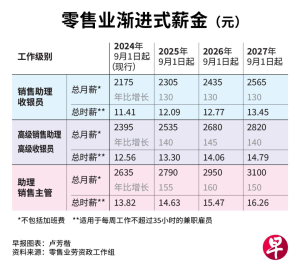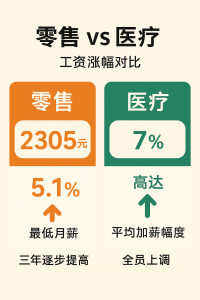Singapore is experiencing a new wave of pay rises! From retail to healthcare, from entry-level to white-collar workers, the minimum monthly salary has increased to 2,035 Singapore dollars, with public healthcare employees receiving a maximum pay rise of 7%, plus official subsidies.
This is not just a numerical increase, but a comprehensive improvement in quality of life, professional dignity, and national competitiveness. Are you one of the lucky ones on this pay raise list?

1. Widespread pay raises—who gets the first increase?
According to reports, Singapore has adopted the recommendations of the Retail Sector Tripartite Working Group. Starting 1 September, the minimum total monthly salary for over 53,000 local retail employees will be raised to 2,305 Singapore dollars; Part-time workers with weekly working hours of less than 35 hours will receive a minimum hourly wage of S$12.09.
‘Have you received a pay raise?’ This has become the hottest topic of conversation in cafes lately. Amidst the pressure of rising living costs and global economic uncertainty, the Singaporean government has launched a new round of wage increases, with a broad scope and rapid implementation, leaving many workers exclaiming, ‘Finally, it’s my turn!’

Source: Lianhe Zaobao
1. Retail sector: Starting at 2,035 Singapore dollars, with a three-year phased wage increase
According to recommendations announced on 11 August by the Tripartite Committee under the Ministry of Manpower (MOM) and the National Trade Union Congress (NTUC), the Progressive Wage Model (PWM) for frontline retail workers will be implemented starting 1 September 2025, with a three-year wage increase plan:
Starting in 2025, the minimum monthly salary for full-time retail employees will be increased to $2,035 (with fixed allowances, it will be $2,305);
In 2026 and 2027, salaries will be increased by an additional $130 to $160 each year, forming a stable ‘step-wise pay increase’;
Part-time employees will also benefit, with the minimum hourly wage being increased simultaneously.
This is not only the largest-scale salary structure adjustment in the history of the retail sector but also the first time the PWM model has been applied to such a wide range of frontline positions. From cashiers to sales assistants, the numbers on pay slips will steadily increase over the next three years.
2. Healthcare Sector: Up to 7% Pay Increase for 63,000 Employees
Frontline staff at Singapore’s three major public healthcare clusters will receive annual pay increases and bonuses in July. The Healthcare Services Employees’ Union secured an average 4.3% pay increase for them this year, and all eligible employees will receive a one-time special allowance of 180 Singapore dollars.
The Ministry of Health (MOH) announced at the end of July that approximately 63,000 employees (including doctors, nurses, medical technicians, and administrative support staff) in public healthcare clusters will receive a maximum pay raise of 7% starting from 1 July 2025. Nurses will receive an average pay raise of 4%, with senior nurses and certain specialised positions also eligible for additional allowances.
Additionally, the public healthcare system will continue to implement the ANGEL Rewards Programme, which provides one-time bonuses to employees who have demonstrated outstanding performance or served in critical roles.
3. Other industries: Entry-level employees and junior managers are also seeing pay increases
According to the Ministry of Manpower (MOM) 2024 Wage Practices Report, the median wage for entry-level employees increased by 5.8% last year, while junior managers saw a 5.6% increase, with higher growth rates in the finance and support sectors.
While these increases are not as prominent as the structural improvements in healthcare and retail, this marks the third consecutive year of positive growth post-pandemic, indicating that the overall wage environment is gradually improving.


II. How does government subsidy benefit employees?
Singapore’s wage increases are not solely driven by market competition; government fiscal support acts as a ‘catalyst.’ Especially during the initial phase of the PWM implementation, employers facing cost pressures can share the burden through subsidy mechanisms.
Last year, employees across all industries and levels saw wage increases, with frontline employees and junior managers seeing increases of 5.8% and 5.6%, respectively, while senior management saw a 5.1% increase. The wage increases in the administrative and support services, financial services, and community, social, and personal services sectors were higher than the national average.
On 28 May, data from the Ministry of Manpower’s 2024 Wage Report showed that wage increases varied slightly across different job roles. Frontline employees in non-management or non-executive roles saw the highest increase at 5.8%; junior managers received a 5.6% increase, slightly lower than the 6.3% increase in the previous year. Senior management with decision-making authority over hiring, firing, promotions, and human resources saw a 5.1% increase in wages, up 0.5 percentage points from the previous year.
The Ministry of Manpower noted that policy factors such as the progressive wage model, as well as the requirement for companies hiring foreign workers to offer local employees a minimum wage of 1,600 Singapore dollars, also contributed to the increase in wages for lower-income employees. Looking ahead, as the progressive wage increase continues, the Ministry of Manpower expects wages for lower-income employees to continue to grow.

Source: Lianhe Zaobao
1. PWCS: A Cost Buffer for Employers
The Progressive Wage Credit Scheme (PWCS) is a national policy implemented by the Inland Revenue Authority of Singapore (IRAS):
In 2025, the government will provide a 40% subsidy for wage increases for PWM employees;
In 2026, the subsidy will be reduced to 20% to help employers gradually adapt;
The subsidy is directly deposited into the company’s account, reducing the employer’s cash flow pressure.
This approach benefits both parties: employees immediately receive higher wages, while employers do not have to bear the full cost of the wage increase at once, reducing the risk of layoffs or staff cuts.
2. Healthcare System: Fiscal Allocations and Talent Retention
The wage increases in the public healthcare sector are supported by official fiscal allocations. The Ministry of Health (MOH) notes that this initiative aims to address healthcare workforce shortages, retain core professional talent, and mitigate poaching competition from private hospitals. This is not merely a wage policy but a strategic investment in the sustainable development of public services.
3. Data Transparency and Enhanced Public Confidence
MOM, MOH, and IRAS annually publish detailed data and policy specifics, enabling employees, employers, and the public to clearly understand the flow of funds and their effects. This transparency is a key reason for public trust in the pay raise policy.

Source: Lianhe Zaobao

III. Among Various Positions, Which Type Are You?
The pay raise wave has arrived, but the magnitude, starting points, and real-world impacts vary significantly across different positions.
1. Doctors and civil servants: Steady increases from a high starting point
The starting salaries for public healthcare doctors are already relatively high, so this pay rise is more of a ‘cherry on top,’ especially for mid-to-senior-level doctors, whose annual salaries may suddenly increase by the price of a small car. While the civil service system did not see a significant pay rise, it maintained steady growth through performance adjustments and salary grade promotions.
2. Sales and Retail: From Low Starting Points to Steady Progression
For retail employees, the base salary of $2,035 is not particularly high, but the PWM’s three-year continuous pay increases provide a clear expectation. Combined with commissions and allowances, actual income may exceed that of many office clerks. For frontline employees who have long worked in low-wage sectors, this is not only a financial improvement but also a boost to professional dignity.
Employees in sectors such as finance, technology, and manufacturing have not benefited from PWM-style salary increases, but industry competition and annual salary adjustment mechanisms still ensure positive wage growth. Especially for those with new skills in AI and data analysis, wage increases have even surpassed those in the healthcare sector.

Source: Lianhe Zaobao

IV. The Significance Behind the Series of Pay Raises
On the surface, this is an increase in wage figures; at a deeper level, it is a crucial step for Singapore to address global challenges and strengthen its social structure.
1. Addressing the Pressure of Living Costs
Over the past three years, living expenses such as housing, food, and transportation have risen significantly. While pay raises may not fully offset inflation, they at least alleviate some of the pressure, giving middle- and low-income groups some breathing room.
2. Attracting and Retaining Talent
In the context of intensifying global talent competition, raising wages is a direct means of retaining local labour and attracting overseas talent. The wage increase in the healthcare sector is an important measure to prevent talent from flowing to the private or overseas markets.
3. Promoting Skill Upgrades and Industry Transformation
PWM is not just about raising wages; it also requires employees to participate in training and improve their skills. In the future, retail employees may not only be salespeople but also ‘new retail’ talent capable of using digital tools and data analysis. This is crucial for the industry’s long-term development.

Source: Lianhe Zaobao
Conclusion: Are you ready?
This round of wage increases is not a fairy tale of overnight wealth but the result of long-term negotiations and cooperation among the government, employers, and employees.
For individuals, while a pay raise is certainly welcome, what is more important is to use this opportunity to enhance skills and plan for the future. After all, salary figures may change, but those who can adapt to change are the true winners.
Next time someone asks you at a coffee shop, ‘Did you get a pay raise?’
Perhaps you can smile and reply, ‘Not just a pay raise, but an increase in value.’
Note: Reference materials sourced from Singapore’s ‘2024 Wage Report,’ ‘2024 Salary Practices Report,’ MOM, NTUC, MOH, IRAS, PWCS, Lianhe Zaobao, and compiled from public news reports. Reproduction must credit the source; contact for removal if infringing…..
